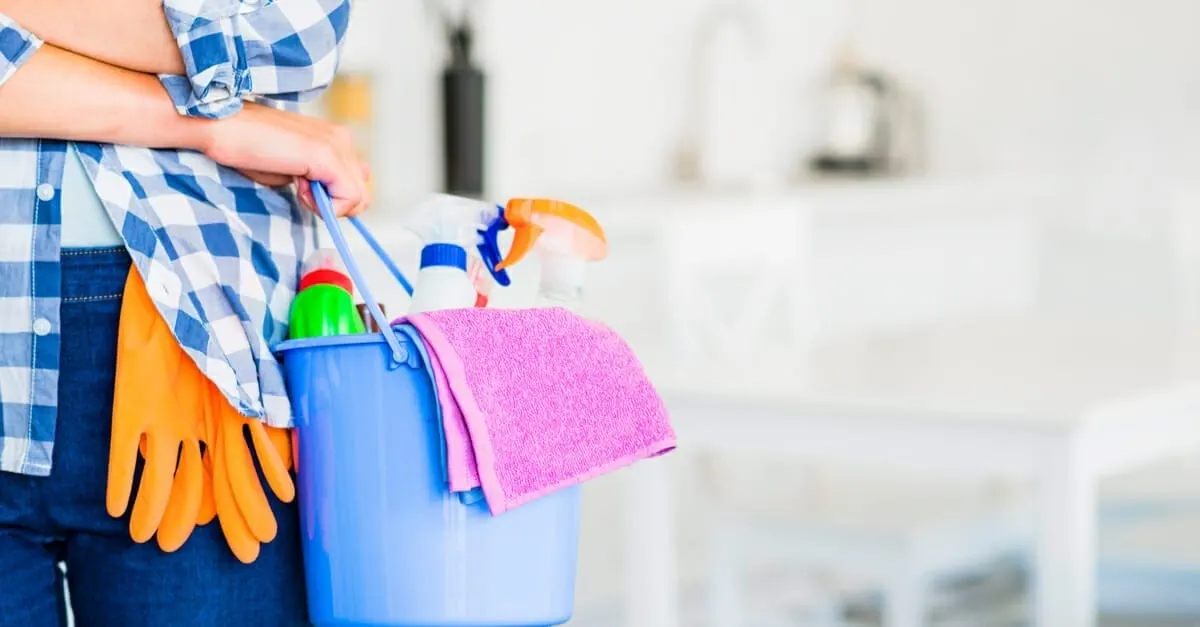Muriatic acid is a very powerful cleaner with many uses around the home.
However, it’s also dangerous. So use it only with care and proper precautions. Read on to learn what you need to know.
What Is Muriatic Acid?
Muriatic acid is another name for hydrochloric acid. When sold for home use, it has usually been diluted with water to about 30 percent acid.
Muriatic acid is inexpensive. You can buy a gallon for less than $10 from many home improvement retailers or online. That’s enough to mix 10 gallons or so of powerful cleaner.
One word of caution: muriatic acid can quickly burn your skin and eyes if you get it on you. It gives off gases that can permanently damage the lungs and nasal passages.
Always wear protective clothing, a full-face mask, and acid-resistant gloves. Most of all, don’t forget to read the directions.
Uses for Muriatic Acid
Muriatic acid is so hard to handle that no one would keep it around if it weren’t so useful. But this strong acid has lots of uses.
It makes a cake walk out of some jobs that nothing else can handle. Some include:
- Cleaning soot, rust marks and other stains from bricks, masonry, and concrete surfaces
- Dissolving crusty white efflorescence from bricks
- Preparing masonry surface for painting by etching and neutralizing excess alkalinity
- To remove rust and hard water stains and deposits from toilet bowls, shower stalls, etc.
- Removing rust from metal
- Mold mitigation
- Cleaning grout from tiles and bricks
- Cleaning swimming pools
- Reducing pool alkalinity
Buying Muriatic Acid
You can get muriatic acid from many hardware, building supply, and maintenance supply stores. Pool supply retailers also carry it.
Safety equipment is necessary when using muriatic acid. You’ll need:
- Gloves, preferably latex rubber or neoprene
- Long-sleeved shirt and pants of thick, preferably chemical-resistant material
- Respirator labeled for filtering gas and vapors
- Safety goggles
- Face mask
In addition, have handy a spray bottle filled with a mixture of baking soda and water. Use half a cup of baking soda in a quart of water.
If acid gets on plants or any other item you don’t want it to, spray it with a baking soda solution. It will help neutralize the corrosive effects.
Also, have nearby a hose that is connected to a spigot. If you get acid on your skin, rinse quickly and thoroughly.
Avoid using muriatic acid in a closed space, and make sure it’s well-ventilated when possible. If necessary, use fans to move air through the space so fumes don’t collect.
How to Use Muriatic Acid

Alexander Raths/Shutterstock
Hardware stores sell muriatic acid in a solution of about 70 percent water and 30 percent acid. Always dilute muriatic acid before using it to clean. The usual mixture is nine parts water to one part acid.
Always pour the water into an acid-proof container first. Then pour the muriatic acid into the water. Never pour acid in first, or pour water into acid.
Never mix muriatic acid with anything but water. Mixing with bleach, for instance, will cause a chemical reaction that releases toxic chlorine gas.
Have the baking soda solution and rinsing hose handy when mixing. If acid gets on plants or anything you don’t want corroded, spray with a soda solution. Then rinse thoroughly.
You may use an ammonia solution to help neutralize the acid after cleaning some things. Mix it now. Use 1 cup of ammonia in a gallon of water.
Cleaning Instructions
When you are safely equipped, carefully brush or spray the acid solution on the area to be cleaned. Let it sit for a few minutes. To etch masonry before painting, wait 10 minutes.
Scrub the area to be cleaned with a brush. Then rinse thoroughly with plenty of water.
When etching bricks before painting, neutralize the acid after cleaning. Also, do this when using a concrete cleaner on a swimming pool bottom.
To neutralize the acid, spray on the ammonia mixture and rinse. Let it dry thoroughly before painting.
If cleaning rust from metal, rinse and dry the metal item thoroughly after cleaning. Any product left behind will corrode the metal further.
Muriatic acid will remove rust stains and hard water deposits from a toilet. Pour a muriatic acid mixture into the bowl. After a few hours, a little scrubbing should remove the rust stains.
Caution: You may hear about using muriatic acid to clean plumbing drains and lines. However, it is not recommended for this purpose.
Adjusting Pool Alkalinity with Muriatic Acid
Muriatic acid is an effective way to manage swimming pool pH levels. When pool water becomes too alkaline, chlorine treatment becomes less effective, and bacteria can flourish.
Swimming pool stores sell muriatic acid to help reduce pool alkalinity. This product for pools is usually sold in a solution of 15 percent acid and 85 percent water.
When used to adjust swimming pool alkalinity, you don’t need to mix the acid. Just carefully pour it directly into the water. And don’t neglect your safety precautions and gear.
Follow the directions on the bottle to adjust the alkalinity of your pool. The amount of muriatic acid needed depends on pool size and alkalinity.
Storing and Disposing of Muriatic Acid
Keep muriatic acid away from where children and pets could reach it. If a child or anyone else gets acid on their skin or eyes, rinse the affected area with water for several minutes. Seek immediate medical attention for acid in the eyes.
If exposed to fumes, rinse your eyes, nose, mouth, and face for several minutes. Seek immediate medical attention for chest pain, wheezing, coughing blood, weakness, or dizziness.
Do not pour excess product on the ground or down a drain. Take it to a hazardous waste facility for disposal.
You have to use it with care and proper equipment. But muriatic acid can handle many cleaning jobs that would otherwise be difficult or even impossible.
